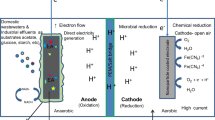Abstract
A microbial fuel cell containing a mixed bacterial culture utilizing glucose as carbon source was enriched to investigate power output in relation to glucose dosage. Electron recovery in terms of electricity up to 89% occurred for glucose feeding rates in the range 0.5–3 g l−1 d−1, at powers up to 3.6 W m−2 of electrode surface, a five fold higher power output than reported thus far. This research indicates that microbial electricity generation offers perspectives for optimization.
Similar content being viewed by others
References
Bond DR, Lovley DR (2003) Electricity production by Geobacter sulfurreducens attached to electrodes. Appl. Environ. Microbiol. 69: 1548–1555.
Bond DR, Holmes DE, Tender LM, Lovley DR (2002) Electrodereducing microorganisms that harvest energy from marine sediments. Science 295: 483–485.
Delaney GM, Bennetto HP, Mason JR, Roller SD, Stirling JL, Thurston CF (1984) Electron-transfer coupling inmicrobial fuel-cells. 2. Performance of fuel-cells containing selected microorganism mediator substrate combinations. J. Chem. Technol. Biot. 34: 13–27.
Greenberg A, Clesceri LS, Eaton AD (1992) Standard Methods for the Examination of Water and Wastewater, 18th edn. Washington: American Public Health Association.
Kubota LT, Munteanu F, Roddick-Lanzilotta A, McQuillan AJ, Gorton L (2000) Electrochemical investigation of some aromatic redox mediators immobilised on titanium phosphate. Quim. Anal. 19: 15–27.
Okawa Y, Nagano M, Hirota S, Kobayashi H, Ohno T, Watanabe M (1999) Tethered mediator biosensor. Mediated electron transfer between redox enzyme and electrode via ferrocene anchored to electrode surface with long poly(oxyethylene) chain. Biosens. Bioelectron. 14: 229–235.
Park DH, Zeikus JG (2003) Improved fuel cell and electrode designs for producing electricity from microbial degradation. Biotechnol. Bioeng. 81: 348–355.
Park DH, Kim SK, Shin IH, Jeong YJ (2000) Electricity production in biofuel cell using modified graphite electrode with neutral red. Biotechnol. Lett. 22: 1301–1304.
Rao JR, Richter GJ, Vonsturm F, Weidlich E (1976) Performance of glucose electrodes and characteristics of different biofuel cell constructions. Bioelectrochem. Bioenerg. 3: 139–150.
Tender LM, Reimers CE, Stecher HA, Holmes DE, Bond DR, Lowy DA, Pilobello K, Fertig SJ, Lovley DR (2002) Harnessing microbially generated power on the seafloor. Nat. Biotechnol. 20: 821–825.
Tsujimura S, Wadano A, Kano K, Ikeda T (2001) Photosynthetic bioelectrochemical cell utilizing cyanobacteria and watergenerating oxidase. Enzyme Microb. Technol. 29: 225–231.
Vandevivere P, Verstraete W(2001) Environmental applications. In: Ratledge C, Kristiansen B, eds. Basic Biotechnology, 2nd edn. Cambridge, UK: Cambridge University Press, pp. 531–557.
Author information
Authors and Affiliations
Corresponding author
Rights and permissions
About this article
Cite this article
Rabaey, K., Lissens, G., Siciliano, S.D. et al. A microbial fuel cell capable of converting glucose to electricity at high rate and efficiency. Biotechnology Letters 25, 1531–1535 (2003). https://doi.org/10.1023/A:1025484009367
Issue Date:
DOI: https://doi.org/10.1023/A:1025484009367




